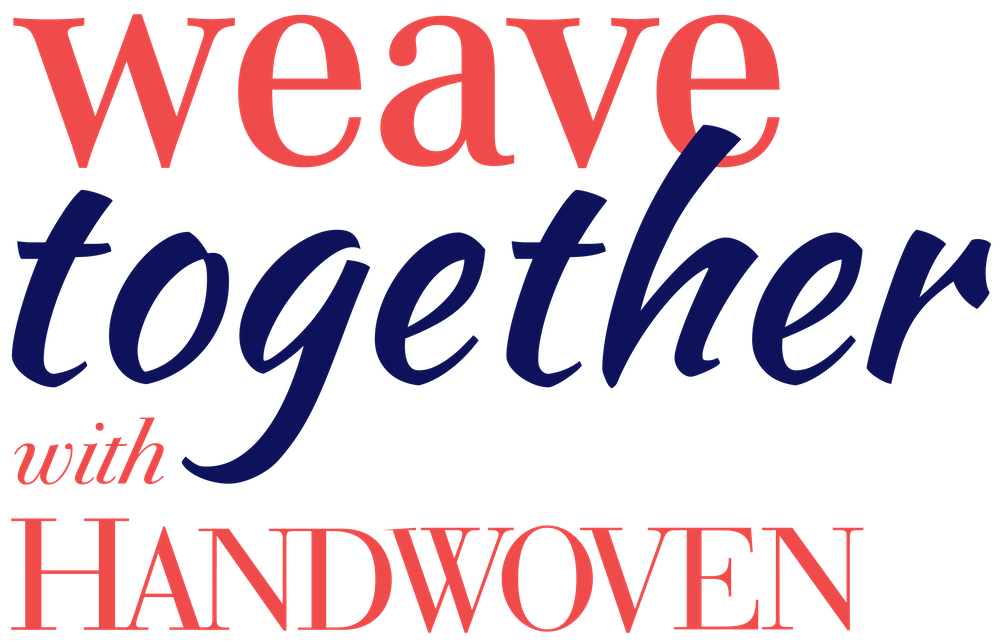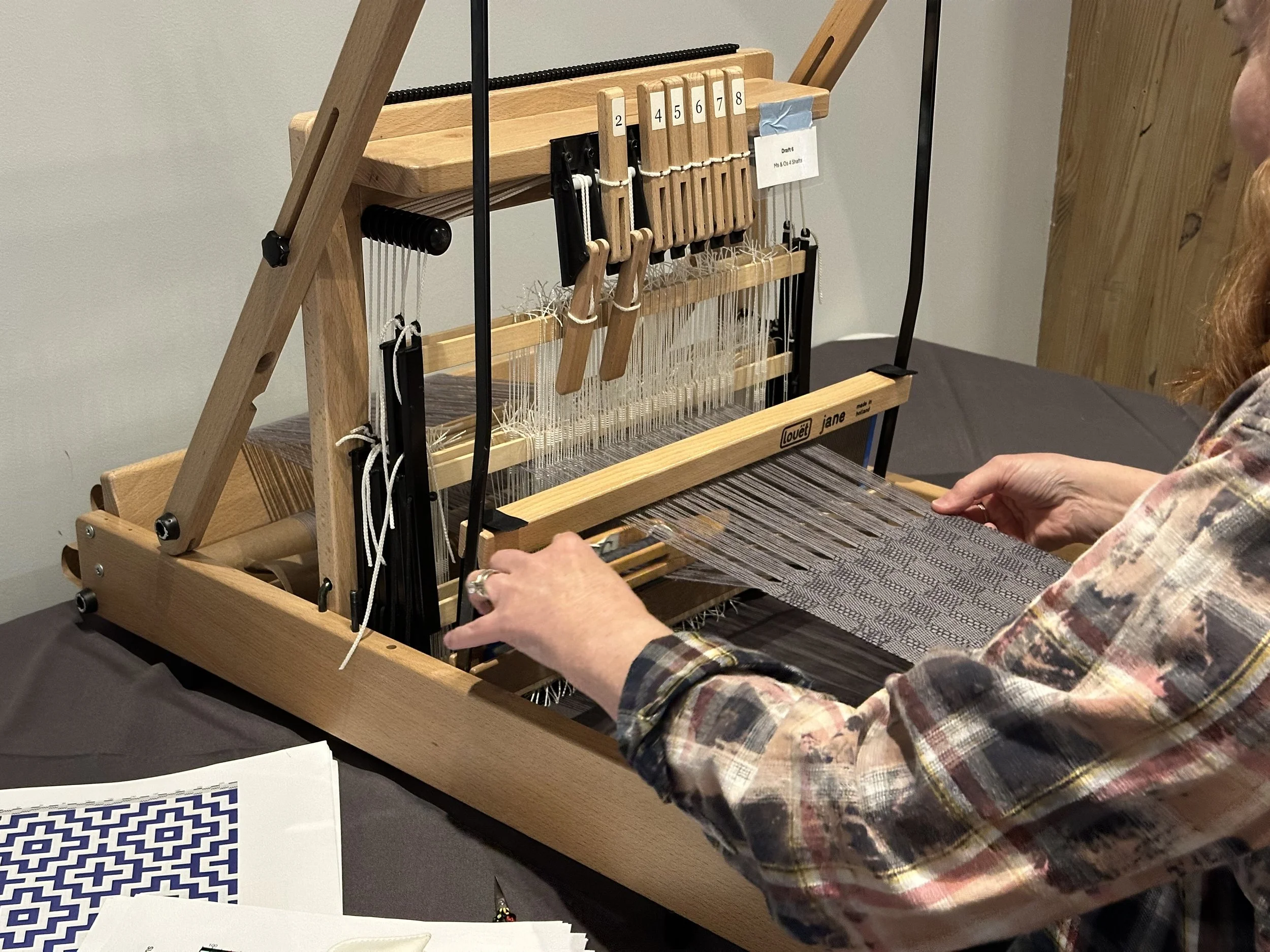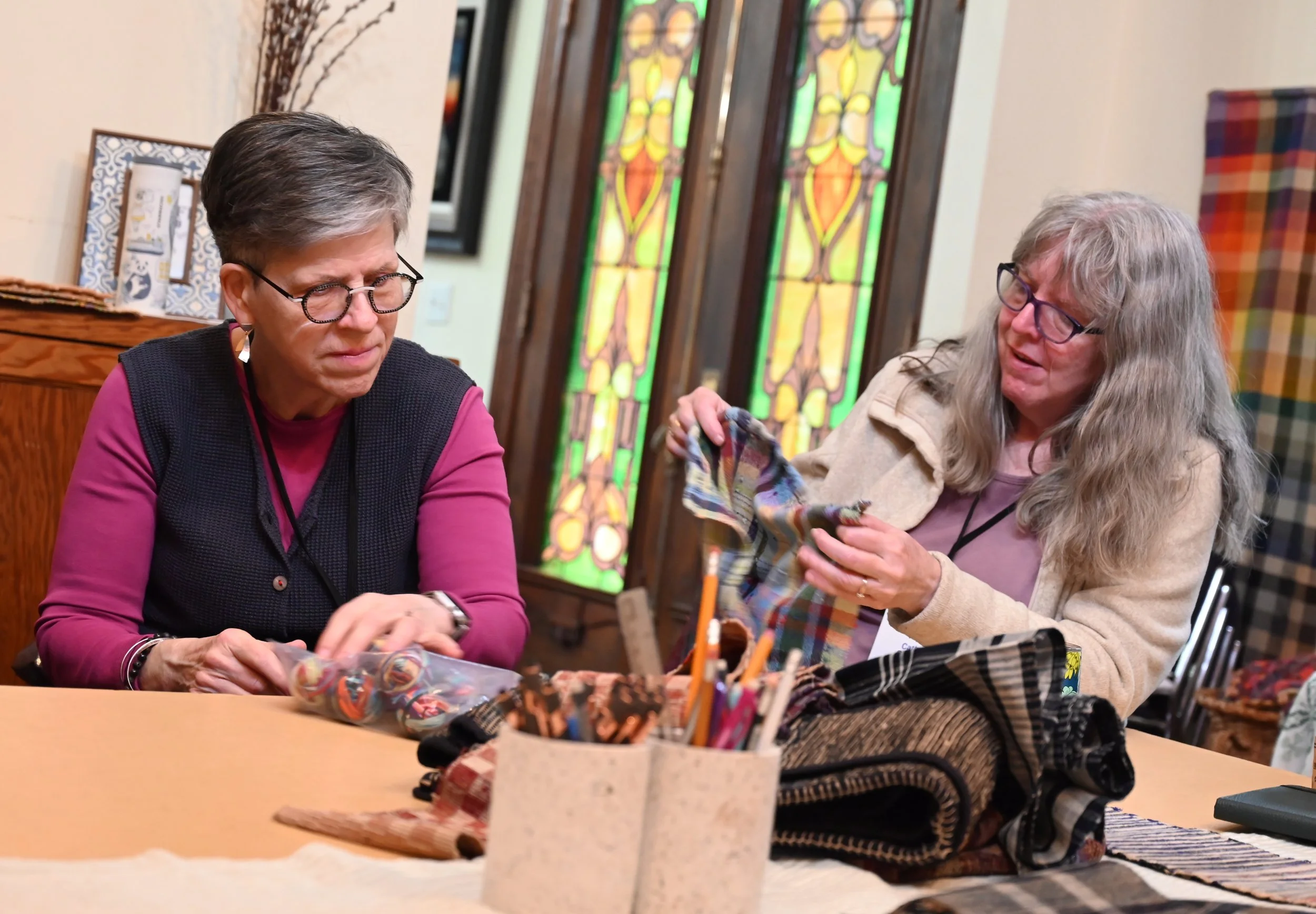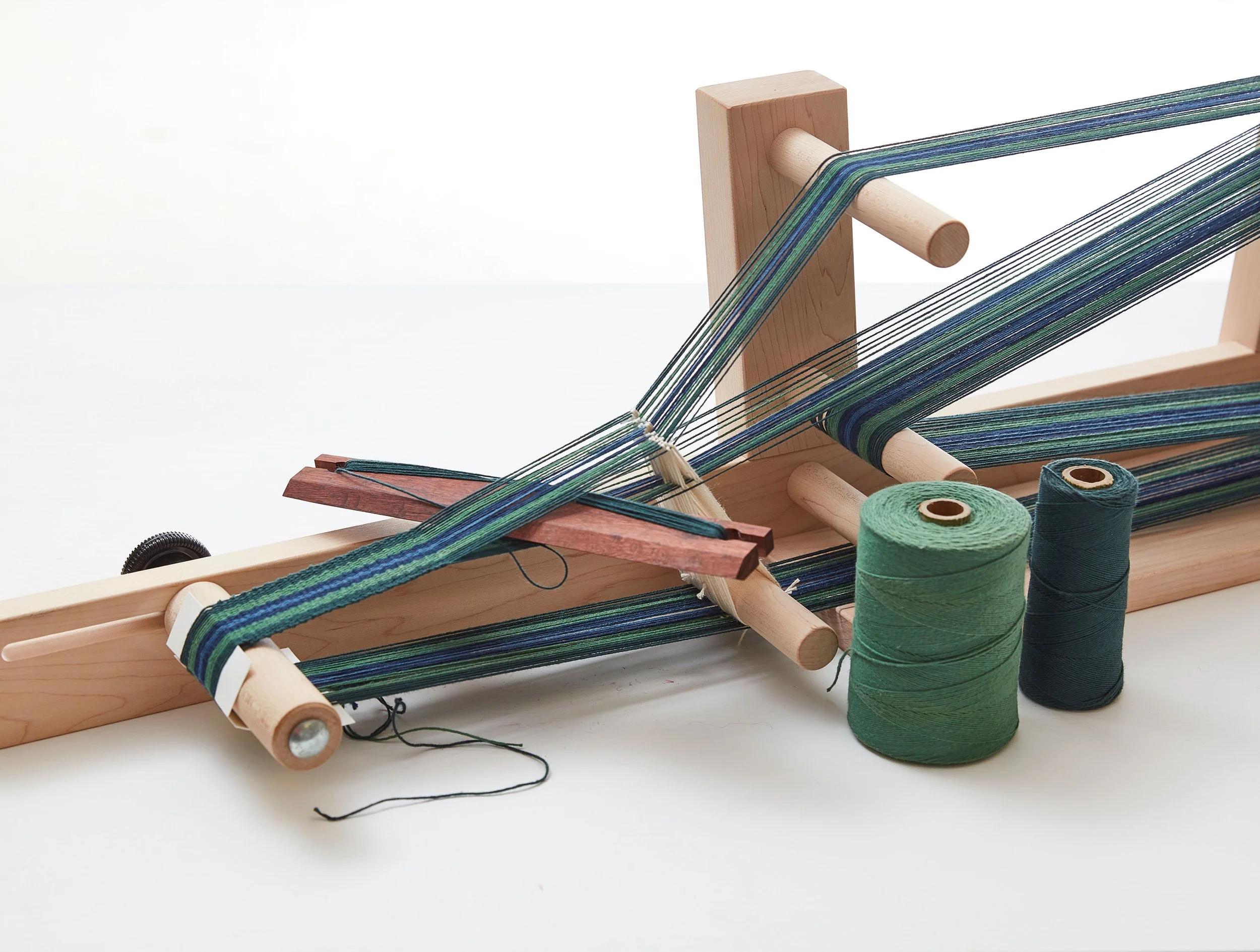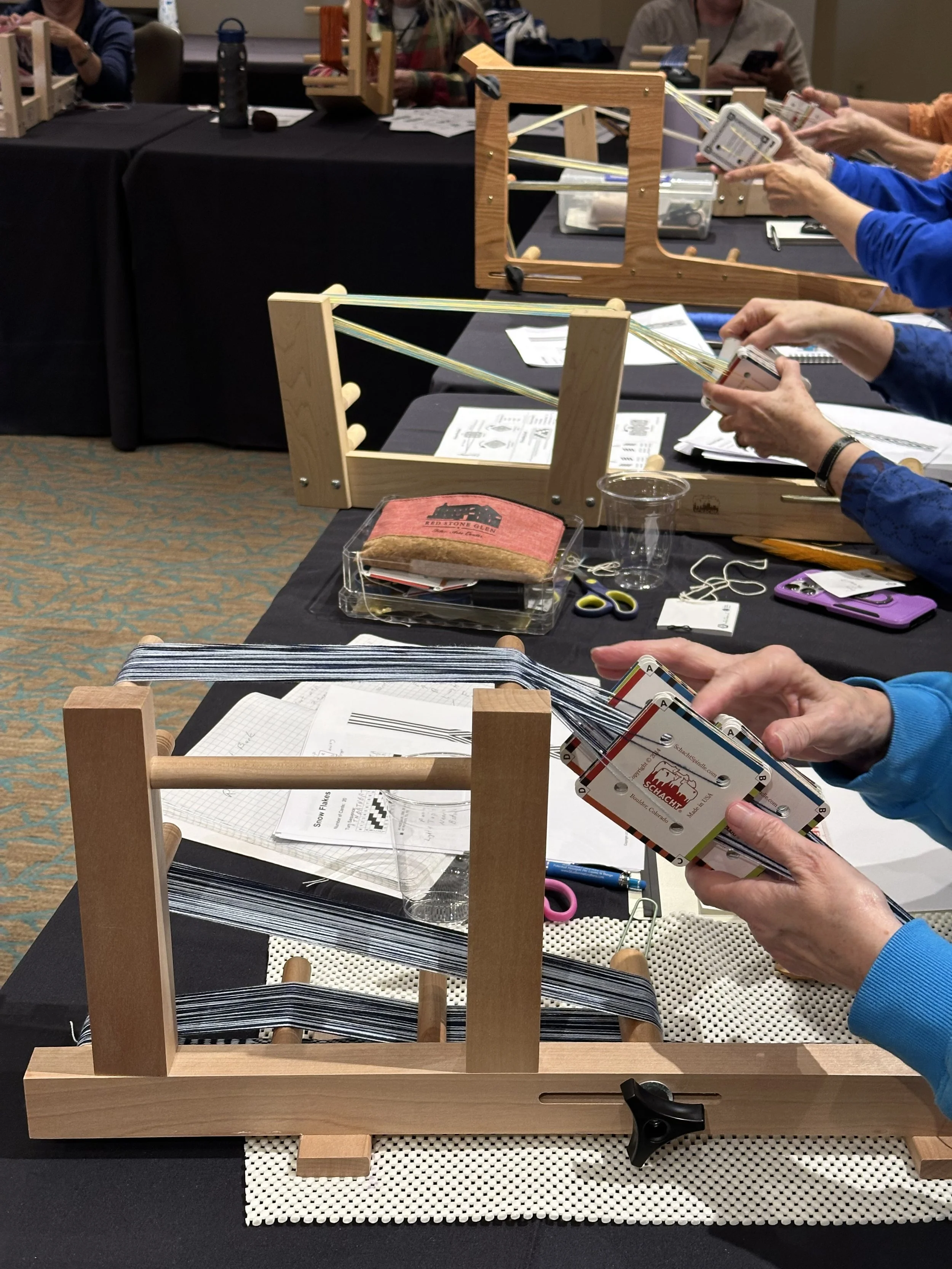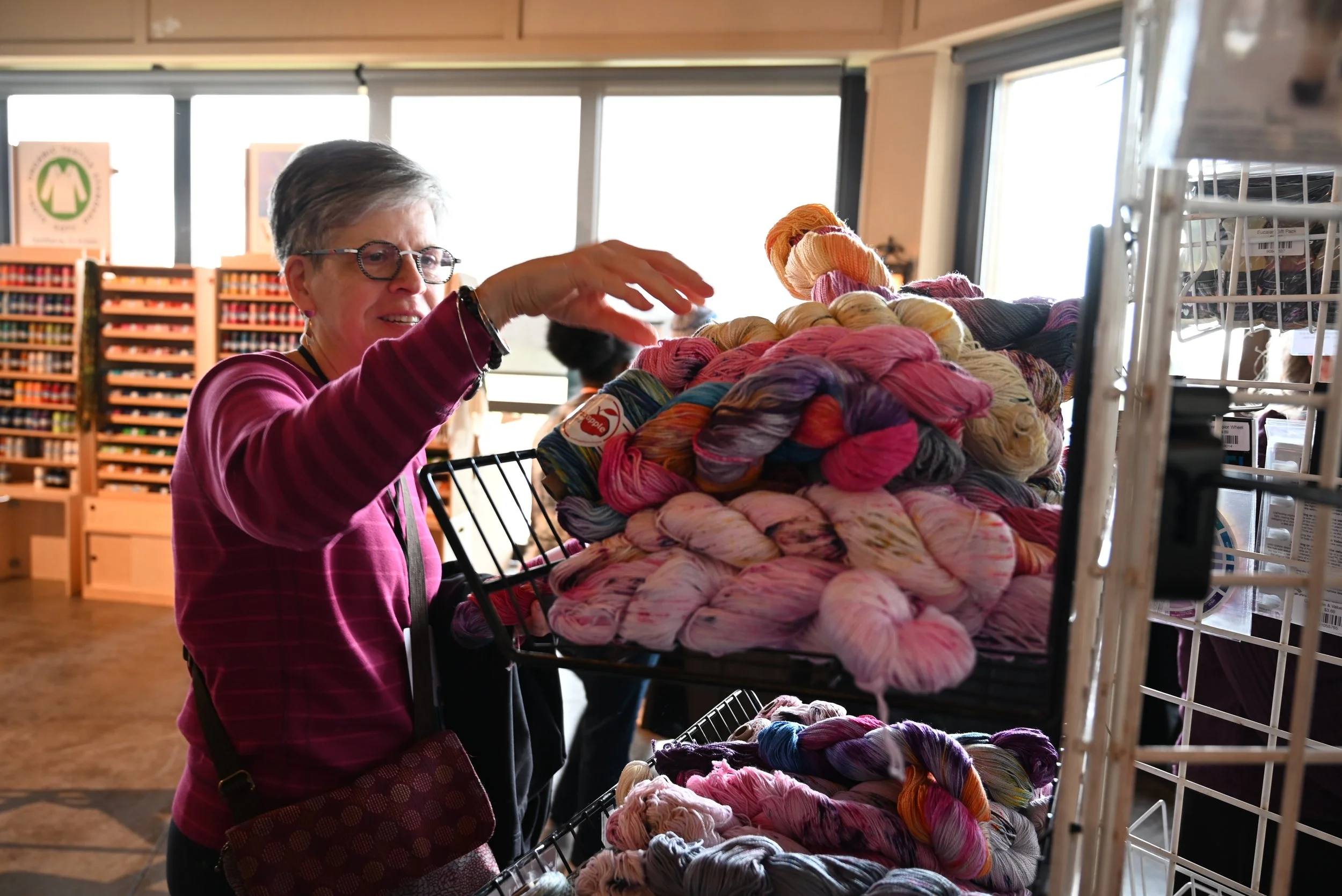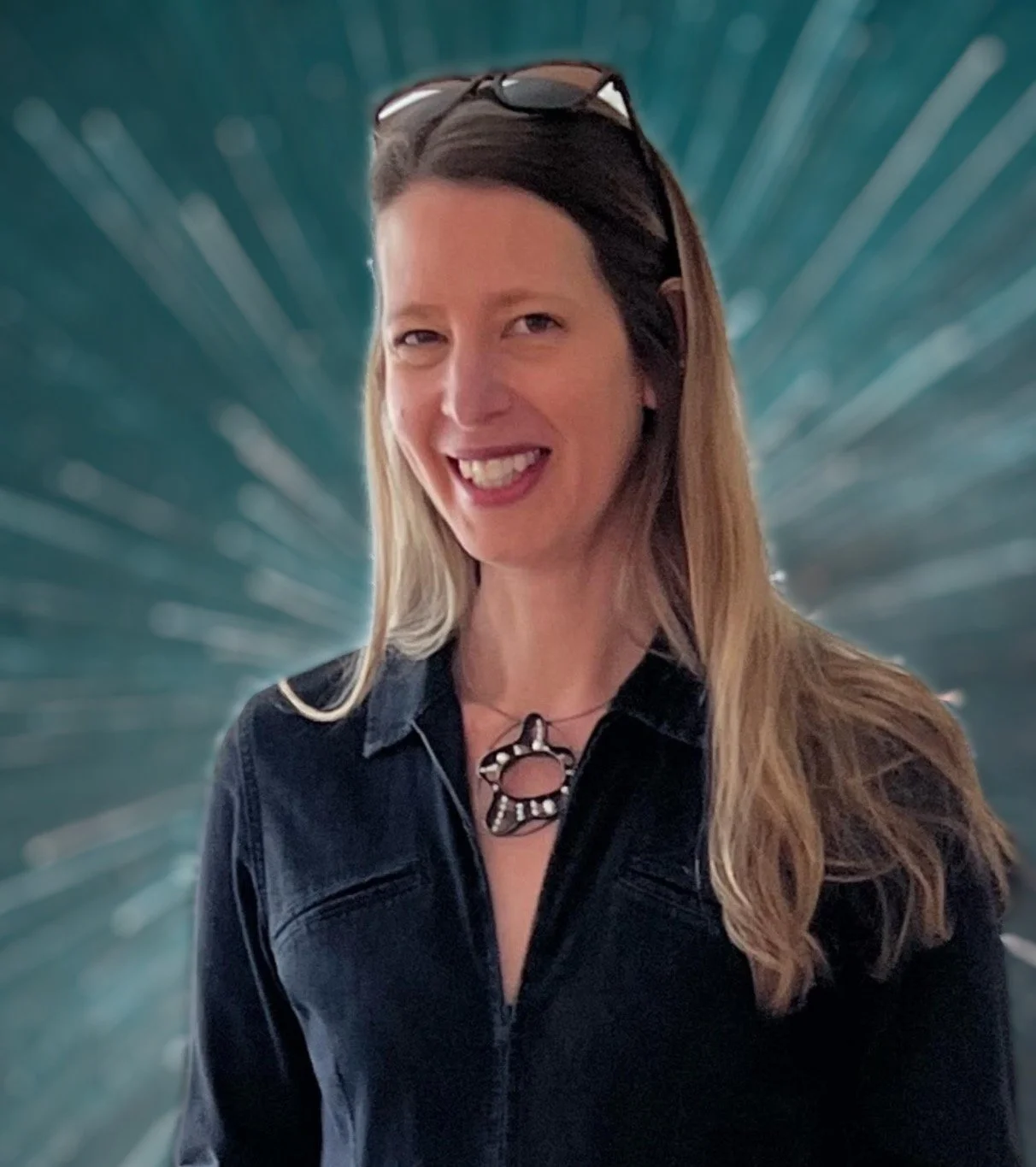Enjoy a Hands-on Weaving Retreat with Handwoven and Little Looms!
Whether you’re a multi-shaft weaver or small looms are more your style, this special event is just for you. From March 8–12, 2026, join us at a beautiful resort in Loveland, Colorado, for four days of weaving, community, and fun. You’ll find something to love in our broad range of courses, all led by top-notch teachers.
Don’t miss this worry-free weaving getaway! All accommodations, breakfasts, lunches, dinners, classes, materials fees, shopping marketplace, and evening events are included, but space is limited.
Tickets on sale for past attendees: July 16, 2025
Tickets generally available: July 17, 2025
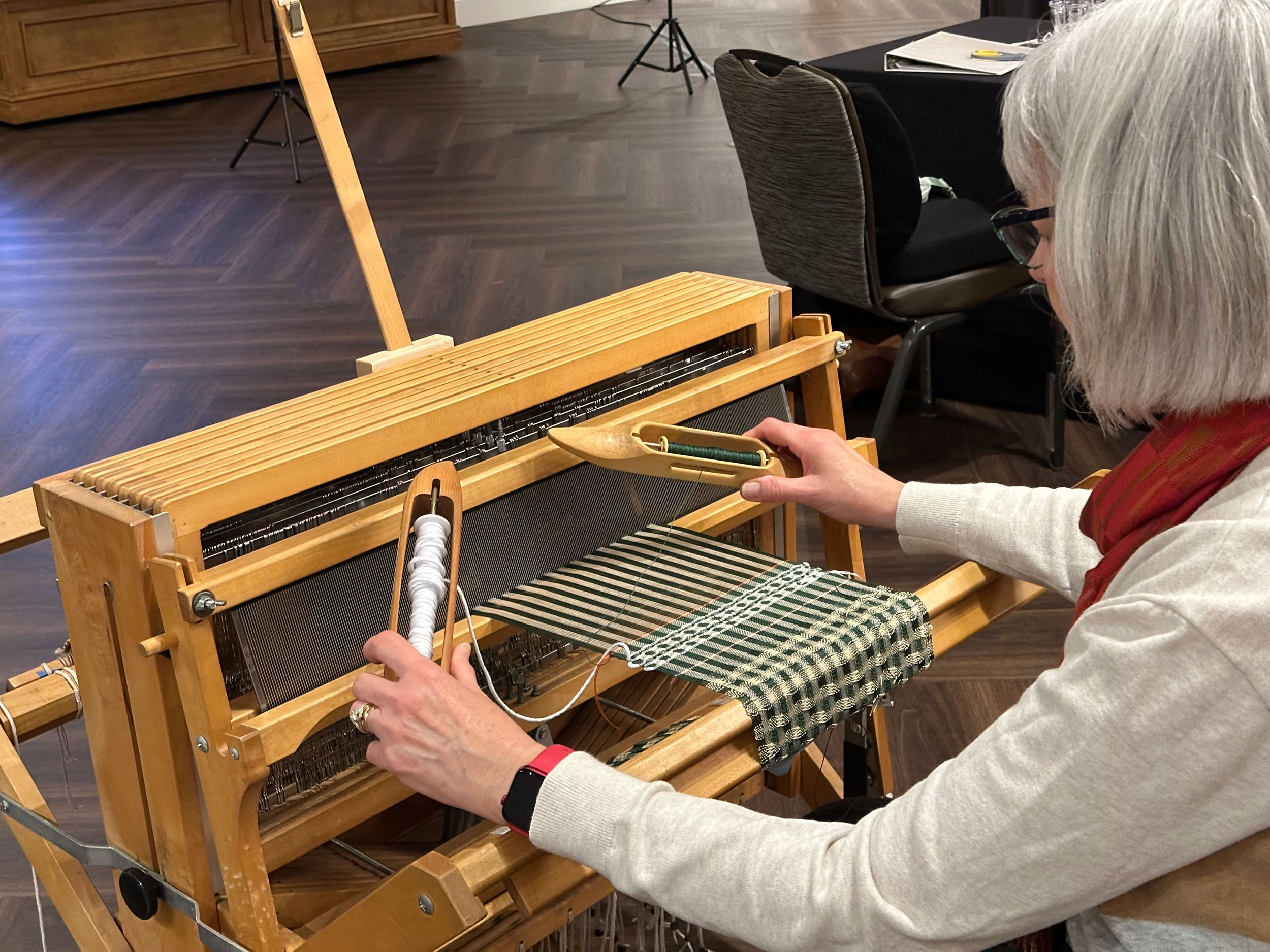
Take a break from your everyday life at the Weave Together with Handwoven and Little Looms retreat, where you’ll learn and weave alongside old and new friends alike. Here’s your chance to expand or sharpen your weaving skills on multi-shaft, pin, inkle, tapestry, and rigid-heddle looms.
You’ll spend your days in engaging classes with great teachers, plus you’ll have opportunities to relax with weaving friends over meals and in the evenings. If you’re in the mood for fiber-y shopping after all that learning, the marketplace will be ready and waiting for you!
What Are Past Attendees Saying?
-
“Truly wonderful experience and I am looking forward to the next event!”
Edward C.
-
“I so enjoyed the camaraderie of being with other weavers and teachers. As a first-time attendee, I was impressed and hope to return next year.”
Rhonda H.
-
“It was everything I had wished and hoped for. A congenial group of people sharing the same interests. The stress of the world just melted away.”
Joan W.
-
“Great classes for a variety of levels of knowledge, terrific food, very organized, wonderful teachers and programs. ...Just amazing. Don't know how you could improve.”
Jane H.
-
”Thank you for a fabulous weaving experience. I did not know what to expect and was simply blown away. My classes were so thorough and well-organized. The company of the other weavers was inspiring. See you next year!“
Vanessa S.
-
”I am very excited about what I learned and am already planning projects for 4-5 of the techniques I tried. It was great! ”
Robin I.
Classes
Monday Classes
Note: Some classes below are 2-day classes. Please check the class type and description for more details.
Tablet Weaving: Ram’s Horn and its Relatives
Instructor: John Mullarkey
Type: 1-day tablet/inkle class
No weaving experience required
Ram’s Horn is a popular beginner’s pattern with many variations. In this class, you’ll learn how to read a draft, set up the cards, and weave this beautiful pattern. Then, using only a few changes to turning, you’ll learn several variations of the Ram’s Horn pattern, including Ivy and Running Dog. No previous tablet-weaving experience is required.
-
Tablets with inkle loom. Note: travel-sized and compact inkles such as the Inklette will not work for this class.
-
Students should plan to bring the following supplies and equipment:
Inkle loom (Note: travel-sized and compact inkles such as the Inklette will not work)
Twenty 4-hole cards
Belt shuttle
Scissors
3 balls or cones of 10/2 cotton or #10 crochet thread in 3 different colors, at least ½ ounce of each
2 pill bottles filled with approximately 5 ounces each of pennies, washers, or other weight
-
None.
-
Instructor will provide class documents.
-
This class is for anyone, even those who have never touched cards before.
Inkle Band Weaving: Basics
Instructor: Jennifer B. Williams
Type: 1-day inkle class
No weaving experience required
The inkle loom is a small loom with considerable potential. In this workshop, discover the joy of weaving simple—or elaborate—bands with an infinite number of uses on this portable little loom. The workshop will cover both plain weave and pick-up. You will also learn how to efficiently warp an inkle loom and read and weave inkle pattern drafts. Jennifer will share her handy tips and tricks for inkle-weaving along the way. Whether you are a beginner or need a refresher class, this workshop is for you.
-
Inkle loom.
-
Students should plan to bring the following supplies and equipment:
Open-sided inkle loom
Weaving yarn (warp and weft)
Yarn for making string heddles (crochet thread or other mercerized cottons work well)
1 belt shuttle
Scissors
-
Note-taking supplies.
-
During class, instructor will provide a custom inkle-weaving tool kit and original weaving drafts and handouts.
-
No previous inkle weaving is required to attend this class.
The Ins and Outs of Fingerweaving
Instructor: Mary Shackleford
Type: 1-day fingerweaving class
No weaving experience required
Mary will share her love of this technique as she helps you learn how to fingerweave. In this comprehensive class, she will teach you how to measure and secure a warp and the four techniques used in fingerweaving: diagonal weave, weaving from the center, changing weft color mid-row, and reversing pattern direction. You will use your new skills to create a sampler or key fob to take home and show off.
About fingerweaving: This precolonial technique was used by Indigenous people to create utilitarian bands out of local grasses or fibrous plants, which they used to carry items. After colonial contact, the grasses were replaced with yarn. Since then, fingerweavers have been creating colorful patterns on bands for decorative belts, straps, and turbans.
-
Non-loom.
-
None.
-
You are welcome to bring your own scissors and tape measure if you have them.
-
Instructor will provide the equipment and materials for your class, including yarn, dowel rods, binder clips, scissors, and a tape measure.
-
No previous fingerweaving experience is required.
That Doesn’t Look Like Plain Weave
Instructor: Karen Donde
Type: 2-day multi-shaft class (looms provided) | Day 1
Quick question: Do you know what double weave, color and weave, deflected double weave, Ms and Os, thick and thin, beiderwand, warp rep, tapestry, honeycomb, huck lace, and transparency weaving have in common? Would you believe they’re all based on plain weave, the simplest of all weave structures? This means that even complex designs using them can be easier to weave than you might think. We’ll explore a selection of these structures, breaking them down to their plain weave roots (while touching on block-design theory), and then you’ll have hands-on weaving time with them. You’ll leave this class full of ideas and a pile of samples for future reference.
Class is currently at capacity. Waitlist requests can be made during class selection.
-
Pre-warped looms will be provided. This is a round-robin style class, using both 4-shaft and 8-shaft looms.
-
Students should plan to bring the following supplies and equipment:
Three-ring binder
Printed copies of slides and supplementary handouts or a tablet or laptop for viewing those resources (see Notes)
-
A tablet or laptop to view slides and digital resources.
-
Printed weaving instructions and drafts will be provided when you arrive. Before class, your instructor will also provide digital copies of lecture slides, a resources list, and supplementary handouts. You may print these yourself and bring them to class, or view them on your digital device if you prefer.
-
This class is appropriate for intermediate multi-shaft weavers or ambitious and fearless advanced beginners.
Clasped Warp and Weft on the Rigid-Heddle Loom
Instructor: Angela Tong
Type: 1-day rigid-heddle class
Create dramatic color changes across your warp and weft with clasping techniques. While most weavers are familiar with clasped weft, they often haven’t tried the technique in the warp. With both techniques, you’ll learn how to control the color patterning by choosing where the colors clasp together. Create blocks of solid color, color gradation, and so much more.
-
Rigid-heddle loom with a 10" minimum weaving width.
-
Students should plan to bring the following supplies and equipment:
EQUIPMENT
10" rigid heddle loom or larger
7.5 or 8 dent heddle
2–4 shuttles
Warping peg
Threading hook
Clamps for loom and warping peg
Warp separator (warping sticks, craft paper, or paper grocery bags)
Tapestry needle
Scissors
Tape measure
YARN
Fingering weight yarn, 3-4 colors that contrast with each other. You can choose 1 variegated/gradient and 3 solids (semi-solids are fine)
Scrap yarn
-
A notebook and pen/pencil.
-
Instructor will provide handouts to students for this class.
-
Students should be comfortable with direct warping a rigid-heddle loom and have experience weaving plain weave on a rigid-heddle loom.
Sakiori and Zanshiori
Instructor: Tom Knisely
Type: 2-day multi-shaft class (looms provided) | Day 1
Join beloved instructor Tom Knisely as you weave and explore two examples of rural Japanese folk fabrics, Sakiori and Zanshiori. On the first day, you will focus on Sakiori, meaning “torn fabric weaving.” You’ll tear fabric strips and weave them into a fine thread warp to create a sturdy fabric. The second day will shift to Zanshiori, translating to “leftover thread weaving.” The numerous knots that appear in the fabric add a pleasing, textural look to the finished fabric. Sakiori and Zanshiori are great examples of how to reuse, recycle, and repurpose fabric waste. Your class also includes information about the frugality and artistic ingenuity of rural Japanese weavers by seeing and handling examples of antique Japanese pieces.
Class is currently at capacity. Waitlist requests can be made during class selection.
-
Instructor will provide looms for use during the class.
-
Students will need to bring the following items to class:
Thrums of leftover 8/2 and 10/2 cotton or Tencel
Finer-weight cotton fabric, such as batiks or prints with good color definition on both sides of the fabric, about 2 yards. If you have extra fabrics that you are willing to share, please bring them along. Old silk and rayon scarves also work well. Thrift shops such as Goodwill are perfect places to look.
Sharp scissors
Notebook, pencil, or pen
Camera or cell phone to take pictures of projects
Reading glasses if you need them
-
A cutting mat with a sharp rotary cutter and guide; shuttles and bobbins.
-
Instructor will provide pre-warped looms, basic weaving equipment, and handouts for this class.
-
Multi-shaft looms will be used during class, but students who are familiar with weaving plain weave on a multi-shaft or rigid-heddle loom will be a good fit for this class.
Tuesday Classes
Note: Some classes below are 2-day classes. Please check the class type and description for more details.
Tablet Weaving: Double-Card Double-Turn Diagonals
Instructor: John Mullarkey
Type: 1-day tablet/inkle class
Also called Egyptian Diagonals, this workshop will focus on weaving diagonal patterns with tablets. You will use the circular warp setup and learn how to use two packs to create mesmerizing diagonal designs. Patterns will be provided during your class, but individual exploration will also be encouraged. No previous tablet-weaving experience is required.
-
Tablets with inkle loom. Note: travel-sized and compact inkles such as the Inklette will not work for this class.
-
Students should plan to bring the following supplies and equipment:
Inkle loom (Note: travel-sized and compact inkles such as the Inklette will not work)
Twenty 4-hole cards
Belt shuttle
Scissors
4 balls or cones of 10/2 mercerized or unmercerized cotton or #10 crochet thread: two balls of one color, and two balls of one different highly contrasting color; each ball should be at least 1 ounce.
-
None.
-
Instructor will provide class documents.
-
This class is for anyone, even those who have never touched cards before.
Explore Inkle: Two-for-One Pick-Up Techniques
Instructor: Jennifer B. Williams
Type: 1-day inkle class
One warp, two techniques. Learn to elevate beautiful plain weave inkle bands to stunning inkle bands in this “next steps” inkle band weaving workshop. You will explore Baltic and horizontal strip-style pick-up techniques on just one warp. Special attention will be given to weaving clear and crisp motifs. Reading pick-up drafts and designing simple patterns will also be covered.
-
Inkle loom.
-
Students should plan to bring the following supplies and equipment:
Pre-warped, open-sided inkle loom
Weaving yarn
Belt shuttle
Scissors
Pen and paper
-
Note-taking supplies.
-
Instructor will provide warping instructions prior to class. During class, Jennifer will provide students with a custom inkle-weaving tool kit and original weaving drafts and handouts.
-
Students should be familiar with warping and weaving plain-weave on an inkle loom.
Shaker Stool Weaving
Instructor: Sara C. Bixler
Type: 1-day Shaker weaving class
No weaving experience required
Shaker handicrafts have inspired artisans for generations. Known for creating pieces that are elegant in their simplicity, many Shaker crafts are sought after by collectors, including their beautiful stools with handwoven seats. In this class, you’ll learn how to weave a small stool seat in the classic tradition of the Shakers while also learning the unique history of the Shakers. Sara will guide you step-by-step through the process; no previous weaving experience is needed to attend.
-
N/A.
-
Students should plan to bring the following supplies and equipment:
Notebook
Pen or pencil
-
None.
-
Instructor will provide all materials for your stool, including a pre-stained stool, shaker tape, and handouts. Sara will also provide additional tools required for weaving. Finished stools will fit in a full-size suitcase, or you can work with the instructor to ship your stool home.
-
No previous weaving experience required.
That Doesn’t Look Like Plain Weave
Instructor: Karen Donde
Type: 2-day multi-shaft class (looms provided) | Day 2
Quick question: Do you know what double weave, color and weave, deflected double weave, Ms and Os, thick and thin, beiderwand, warp rep, tapestry, honeycomb, huck lace, and transparency weaving have in common? Would you believe they’re all based on plain weave, the simplest of all weave structures? This means that even complex designs using them can be easier to weave than you might think. We’ll explore a selection of these structures, breaking them down to their plain weave roots (while touching on block-design theory), and then you’ll have hands-on weaving time with them. You’ll leave this class full of ideas and a pile of samples for future reference.
Class is currently at capacity. Waitlist requests can be made during class selection.
-
Pre-warped looms will be provided. This is a round-robin style class, using both 4-shaft and 8-shaft looms.
-
Students should plan to bring the following supplies and equipment:
Three-ring binder
Printed copies of slides and supplementary handouts or a tablet or laptop for viewing those resources (see Notes)
-
A tablet or laptop to view slides and digital resources.
-
Printed weaving instructions and drafts will be provided when you arrive. Before class, your instructor will also provide digital copies of lecture slides, a resources list, and supplementary handouts. You may print these yourself and bring them to class, or view them on your digital device if you prefer.
-
This class is appropriate for intermediate multi-shaft weavers or ambitious and fearless advanced beginners.
Overshot Weaving on the Rigid-Heddle Loom
Instructor: Angela Tong
Type: 1-day rigid-heddle class
Learn how to weave beautiful overshot patterns on the rigid-heddle loom using just one heddle and a pick-up stick. Angela will go over all the basics of overshot to get you started on this new weaving adventure. Create endless weaving possibilities as you learn to weave complex patterns using pick-up techniques.
Class is currently at capacity. Waitlist requests can be made during class selection.
-
Rigid-heddle loom with a 10" minimum weaving width.
-
Students should plan to bring the following supplies and equipment:
EQUIPMENT
10" rigid heddle loom or larger (warped for class)
7.50- or 8-dent heddle
2–3 shuttles
Pick-up stick
Tapestry needle
Scissors
Tape measure
YARN
Warp: 8/4 or 3/2 cotton or cotton blend OR sport weight/dk weight wool or wool blend
Weft (tabby): Sport-weight cotton/cotton blend OR Sport-weight wool/wool blend in a solid color that will contrast against your Weft Pattern Yarns
Weft (Pattern): Worsted-weight cotton/cotton blend OR Worsted-weight wool/wool blend in 2-3 colors that will contrast against your Weft Tabby Yarn
Scrap yarn
-
A notebook and pen/pencil.
-
Warping instructions will be provided prior to class. Instructor will provide handouts to students for this class.
-
Students should be familiar with warping and weaving plain weave on a rigid-heddle loom.
Sakiori and Zanshiori
Instructor: Tom Knisely
Type: 2-day multi-shaft class (looms provided) | Day 2
Join beloved instructor Tom Knisely as you weave and explore two examples of rural Japanese folk fabrics, Sakiori and Zanshiori. On the first day, you will focus on Sakiori, meaning “torn fabric weaving.” You’ll tear fabric strips and weave them into a fine thread warp to create a sturdy fabric. The second day will shift to Zanshiori, translating to “leftover thread weaving.” The numerous knots that appear in the fabric add a pleasing, textural look to the finished fabric. Sakiori and Zanshiori are great examples of how to reuse, recycle, and repurpose fabric waste. Your class also includes information about the frugality and artistic ingenuity of rural Japanese weavers by seeing and handling examples of antique Japanese pieces.
Class is currently at capacity. Waitlist requests can be made during class selection.
-
Instructor will provide looms for use during the class.
-
Students will need to bring the following items to class:
Thrums of leftover 8/2 and 10/2 cotton or Tencel
Finer-weight cotton fabric, such as batiks or prints with good color definition on both sides of the fabric, about 2 yards. If you have extra fabrics that you are willing to share, please bring them along. Old silk and rayon scarves also work well. Thrift shops such as Goodwill are perfect places to look.
Sharp scissors
Notebook, pencil, or pen
Camera or cell phone to take pictures of projects
Reading glasses if you need them
-
A cutting mat with a sharp rotary cutter and guide; shuttles and bobbins.
-
Instructor will provide pre-warped looms, basic weaving equipment, and handouts for this class.
-
Multi-shaft looms will be used during class, but students who are familiar with weaving plain weave on a multi-shaft or rigid-heddle loom will be a good fit for this class.
Wednesday Classes
Note: Some classes below are half-day classes. Please check the class type and description for more details.
Tablet-Woven Shoelaces
Instructor: John Mullarkey
Type: 1-day tablet/inkle class
No weaving experience required
The humble shoelace is the perfect canvas for practicing the fundamentals of tablet weaving. With 10/2 or crochet cotton and a deck of cards, you can make custom laces that match your style. Tablet weaving is incredibly durable, so your laces will outlast your shoes! You’ll leave with the skills to successfully warp, weave, follow a pattern, and finish a tablet-woven band. No previous tablet-weaving experience is required.
-
Tablets with inkle loom. Note: travel-sized and compact inkles such as the Inklette will not work for this class.
-
Students should plan to bring the following supplies and equipment:
Inkle loom (Note: travel-sized and compact inkles such as the Inklette will not work)
Twenty 4-hole cards
Belt shuttle
Scissors
4 balls or cones of 10/2 mercerized or unmercerized cotton or #10 crochet thread: two balls of one color, and two balls of one different highly contrasting color; each ball should be at least 1/2 ounce.
-
None.
-
Instructor will provide class documents.
-
This class is for anyone, even those who have never touched cards before.
Bedouin-Inspired Bands on the Inkle Loom
Instructor: Jennifer B. Williams
Type: 1-day inkle class
Traditionally woven on large, horizontal ground looms, Bedouin textiles are known for their intricate geometric patterns. In this class, you will use an inkle loom to explore the complementary warp pick-up technique skillfully used by Bedouin weavers for centuries. Create beautiful Bedouin-inspired inkle bands as you delve into the world of Bedouin weaving.
-
Inkle loom.
-
Students should plan to bring the following supplies and equipment:
Pre-warped, open-sided inkle loom
Weaving yarn
Belt shuttle
Scissors
Pen and paper
-
Note-taking supplies.
-
Instructor will provide warping instructions prior to class. During class, Jennifer will provide students with a custom inkle-weaving tool kit and original weaving drafts and handouts.
-
Students should be familiar with warping and weaving pick-up patterning on the inkle loom.
Surface Embellishment Sampler
Instructor: Sara C. Bixler
Type: 1-day rigid-heddle OR multi-shaft loom class
Transform your woven cloth from ordinary to extraordinary with surface embellishment techniques. In this class, you will learn various hand-manipulation techniques to add visual and textural interest to your weaving, including Danish medallions, decorative internal hemstitching, inlay, and more. You will create samplers using these techniques to showcase what you learned during each lesson.
-
Multi-shaft loom, table loom, or rigid-heddle loom with a 15" minimum weaving width.
-
Students should plan to bring the following supplies and equipment:
Pre-warped multi-shaft/table or rigid-heddle loom in good working order
Boat shuttle with bobbins or 2 stick shuttles
Weft materials
Scissors
Reading glasses if needed
Notebook
Pen or pencil
-
None.
-
Instructor will provide warping instructions before the event, including material usage, sett, width, and recommended warp length. Sara will also provide pick-up sticks and various tools specific to each technique, such as beading crochet hooks and special tapestry needles. During class, you’ll also have access to bins of fun novelty yarns and netting shuttles.
-
Weavers should have basic weaving skills and be familiar with weaving plain weave on either a multi-shaft, table loom, or rigid-heddle loom.
How to Design: Starting with Pictures
Instructor: Karen Donde
Type: 3-hour design class | AM Class
Ever get stuck trying to decide what to weave next? This group exercise will rev up your personal creative engine using photos as inspiration. For class, you’ll bring interesting pictures you’ve cut from magazines or old calendars, printed photos from a vacation or your garden—whatever catches your eye. Karen will teach you how to interpret colors, patterns, and shapes from them and organize your inspirations. You’ll discuss ways to transform your inspiration board into designs and share ideas among the group. Leave with new design tools—and maybe even your next project!
-
N/A.
-
Students should plan to bring the following supplies and equipment:
25–30 inspirational pictures cut from magazines, catalogs, or printed from your own photos
Pen or pencil
Yarn scraps of various types and colors
Scissors
Tape
-
A color wheel and a sketchbook to save your images and ideas.
-
Instructor will provide links to design tools that you can print for use during class, along with a list of resources and lecture slides. Your instructor will also provide cards for yarn wraps and extra yarn scraps.
-
No previous design experience needed.
How to Design: Starting with Stash
Instructor: Karen Donde
Type: 3-hour design class | PM Class
Do you have yarn lingering on your shelf in search of the right project? Karen will guide you through developing design plans using yarn you already have on hand, especially those “challenge” yarns that linger in our stash in search of the right project.
Topics include:
Evaluating yarn qualities and properties
Applying that knowledge to the design
Combining different stash yarns
Using color and proportion tools
Finding patterns that emphasize the yarns’ best qualities
Selecting the best weave structure to bring the cloth to life
-
N/A.
-
Students will need to bring the following items to class:
1 cone, skein, or sample (at least 1 yard long) of a challenge yarn from your stash that you’d like to figure out how to use. If there is one you want to use with it, bring that too.
All the information you know about this yarn: fiber, size, how it was processed, where it came from, age, etc. It’s OK if you’re not sure.
Sketchbook or notebook to record ideas, drawings, or pictures, etc.
Pencil or pen
Scissors
A few colored pencils
Clear tape or glue stick
Color wheel
-
You may also bring a book with lots of weave structure examples, a few extra magazine issues to share, and a laptop or tablet (especially if you have a subscription to Handweaving.net).
-
Instructor will provide a project planning workbook for students to print and bring to class, along with other digital handouts and lists of tools and resources. During class, Karen will provide cards for yarn wraps and extra yarn scraps.
-
No previous design experience needed.
Finishing Techniques for Rugs
Instructor: Tom Knisely
Type: 1-day finishing techniques class
Learn numerous ways to finish your handwoven rugs with finesse. You will be given a small handwoven mat to practice each technique, including finishes for weft and warp protection. Learn how to properly tie a knotted edge, how and why you might want to use either a full or half Damascus edge, and how to do several other fringe treatments that are both functional and beautiful. Other techniques include sewing a rolled hem on a rug and finishing treatments that work well with warp-faced rugs.
-
No loom will be needed for this class.
-
Students will need to bring the following items to class:
A heavy book or weight such as an old cast iron iron to hold your mat down onto a table surface
Scissors
Camera or cell phone to take pictures
Two clamp fringe twister
-
None.
-
Instructor will provide a pre-woven rag rug sample so you can sample the techniques during class.
-
None.
A Little Taste of Fingerweaving
Instructor: Mary Shackleford
Type: 3-hour fingerweaving class | AM Class
No weaving experience required
This half-day class is a great way to try fingerweaving. In just a few short hours, you will learn how to measure and secure a warp, the foundational diagonal weave stitch used in fingerweaving, and some simple variations. You will create a sampler during class to take with you.
-
Non-loom.
-
None.
-
You are welcome to bring your own scissors and tape measure if you have them.
-
Instructor will provide the equipment and materials for your class, including yarn, dowel rods, binder clips, scissors, and a tape measure.
-
No previous fingerweaving experience is required.
-
This precolonial technique was used by Indigenous people to create utilitarian bands out of local grasses or fibrous plants, which they used to carry items. After colonial contact, the grasses were replaced with yarn. Since then, fingerweavers have been creating colorful patterns on bands for decorative belts, straps, and turbans.
A Little Taste of Twining
Instructor: Mary Shackleford
Type: 3-hour twining class | PM Class
No weaving experience required
This short class is the perfect introduction to twining. During class, Mary will teach you how to begin a piece, proceed with the twining technique, and introduce patterns, as well as different methods for finishing a piece and closing the bottom. You will create a small bag to take home with you to show off what you learned.
-
Non-loom.
-
None.
-
None.
-
Instructor will provide the equipment and materials for your class, including a cardboard “loom,” twine/yarn, and scissors.
-
No previous twining experience is required.
-
This ancient fiber-twisting technique was used by Indigenous people to create bags, fishing nets, and even dresses with cordage spun from tree bark (or other plant fibers), or bear or buffalo fur. Modern Indigenous people still use twining to create bags for tribal events.
Pin Loom Party
Instructor: Angela K. Schneider
Type: 3-hour pin loom class | AM Class
No weaving experience required
Do you have yarn leftovers? Are you looking for a good time? In this half-day class, Angela will teach you to weave on the exceptionally portable and wonderfully versatile pin looms. While they’ve been around since the early 1940s, these little looms are enjoying new popularity because they use only small amounts of yarn—and the weaving is both quick and fun. You’ll learn the basic weave, additional patterns, and joining techniques. Then, explore ways to stitch the finished pieces together or sculpt them into larger items.
Class is currently at capacity. Waitlist requests can be made during class selection.
-
2" or 4" square pin loom.
-
Students should plan to bring the following supplies and equipment:
2" or 4" square pin loom with 3-pin configuration
Weaving needle, tapestry needle
Fork
Assorted worsted-weight yarn
-
Students may also bring a crochet hook, size G-4 6mm or similar size, and scissors.
-
Instructor will provide printed instructions and patterns.
-
No previous weaving experience is required.
-
Instructor will provide kumihimo disks.
-
None.
-
You are welcome to bring your own braiding disk if you have one.
-
Instructor will provide braiding disks and yarn for students to use during class.
-
No previous kumihimo experience is required.
Kumihimo Starter
Instructor: Angela K. Schneider
Type: 3-hour kumihimo class (disks provided) | PM Class
No weaving experience required
Kumihimo braids have a rich history that goes back over 1,400 years. During that history, these elaborate braids have been used in jewelry, home décor, and as custom accents for handwoven projects. In this short class, Angela will teach you how to follow braiding patterns on a portable hand-held disk (yours to keep!), and you’ll also be able to try them out on a marudai braiding stool. You’ll create a sampler of several shapes and designs to take home.
What About Equipment?
You should plan to bring your own looms if that’s possible. You’re already comfortable working on them, and at the end of the retreat, you can take home any of your work in progress. But if your travel plans will make that challenging, or if you’re taking a class on a new-to-you loom, we’ll make arrangements to borrow a limited number of looms from local weavers and companies.
About 2-3 months before the event, we’ll send out an equipment survey and rental options for your classes.
Meet the Instructors
At Weave Together, you’ll learn from some of the most renowned weavers and fiber artists in the world. This year’s all-star lineup includes these new and returning instructors.
-

Angela Tong
Angela Tong is a Chinese-American fiber artist and ceramicist living in Pennsylvania. A former Boston native, she studied at Massachusetts College of Art and then at the Fashion Institute of Technology. She designs knitting, crochet, and weaving patterns for books, magazines, and yarn companies. She also teaches workshops across the country and online because she loves encouraging people to learn new skills. Her love of small looms is evident in the projects she designs and videos she’s released for Easy Weaving with Little Looms. Meet this beloved instructor in our Five Questions with Angela Tong article.
-

Annie MacHale
Annie MacHale first discovered the inkle loom at the age of 17, sparking a lifelong love affair with bandweaving. She built her first loom in 1976 with the help of her dad and a library book. Annie is known to many weavers because of her blog, ASpinnerWeaver.com. She has published two books, In Celebration of Plain Weave: Color and Design Inspiration for Inkle Weavers and Three-Color Pickup for Inkle Weavers: A Modern Look at an Ancient Baltic-Style Technique. In her workshops, she shares her decades of experience as a weaver working exclusively on inkle looms, her unique insights into working with color, and her explorations of three-color pick-up. Listen in to our podcast with Annie MacHale and learn more about her fascination with bandweaving.
-

Deborah Silver
Deborah Silver teaches the art of split-shed weaving, a selvedge-to-selvedge technique that allows weavers to break out of blocks, weave curves, and blend colors in multiple weave structures. She is the author of a book about the process (The Technique of Split-Shed Weaving) and she also lectures about her technique, her artwork, and the creative process. Deborah earned a BFA in Fiber from the Cleveland Institute of Art. Her work has been shown in many national and international juried exhibitions, winning several prizes, including the ComplexWeavers Award and First Place in Complexity 2018: Innovations in Weaving. Check out this article to see how Deborah Silver has been expanding our knowledge of split-shed weaving with her explorations and her recently updated book.
-

Dorothy Tuthill
Dorothy Tuthill is a Master Weaverand naturalist. When Dorothy first learned to weave, she knew that she would continue doing it for the rest of her life. Forty-five years later, she’s still exploring the intersections of color and structure, never weaving anything with two colors if four or more will work. Her profession as a botanist and mycologist informs her color decisions, because all colors and color combinations are found in the natural world. Now retired, she can be found weaving and teaching at her local yarn shop, Cowgirl Yarn, except when she’s out exploring the beautiful landscapes around her Wyoming home.
-

John Mullarkey
John Mullarkey is passionate about teaching tablet weaving and exploring ways to make the art form more contemporary. Tablet weaving is a primitive technique that creates simple weave structures while offering great variation in patterning. John loves to push the technique beyond its customary limits to create original and surprising interpretations of traditional structures and designs. He is a nationally recognized teacher, valued for the patience, clarity, and organization he brings to his classes. John left his earlier software development career more than a decade ago to focus on weaving and teaching full-time. Enjoy our podcast with John Mullarkey or this artist spotlight article to learn how he came across the ancient craft of tablet weaving and fell in love with teaching.
-

Lynda Teller Pete
Lynda Teller Pete is a fifth-generation Diné (Navajo) weaver who specializes in Two Grey Hills tapestries. This style is identified primarily by a double-diamond layout, intricate geometric design using natural-colored, hand-carded, and handspun wool, as well as high weft counts. A frequent advisor on Diné weaving traditions to museums, universities, and other art venues, Pete has also received fellowships as a native artist. She was on the curatorial team for the exhibition Horizons: Weaving Between the Lines with Diné Textiles (Museum of Indian Arts and Culture, in Santa Fe, NM). With her sister, Barbara Teller Ornelas, she coauthored the books Spider Woman's Children: Navajo Weavers Today and How to Weave a Navajo Rug and Other Lessons from Spider Woman. Meet Lynda Teller Pete in this podcast episode and explore the two worlds she lives in: that of a traditional Navajo woman weaving exquisite textiles, and that of a book author, curator, board member, and world traveler. (Photo courtesy of Tia Howard.)
-
Sara Goldenberg White
Sara Goldenberg White has been sharing her love of weaving and other fiber techniques in classrooms along the Front Range for over a decade. Her passion for weaving and teaching started during her graduate study at Colorado State University. Sara coauthored (with Jane Patrick) Simple Woven Garments. Other projects she has designed can be found in The Weaver's Idea Book, Woven Scarves, Easy Weaving with Little Looms, and Handwoven. Sara has released two rigid-heddle weaving videos with Long Thread Media, and she creates weaving kits that can be found at SGWTextileArt.com. Sara has a lively fine arts practice and has exhibited her work at museums and galleries throughout the country. Read our Spotlight on Sara Goldenberg White article to see why Sara is a woman of many talents. She looks forward to seeing you at Weave Together 2026!
-
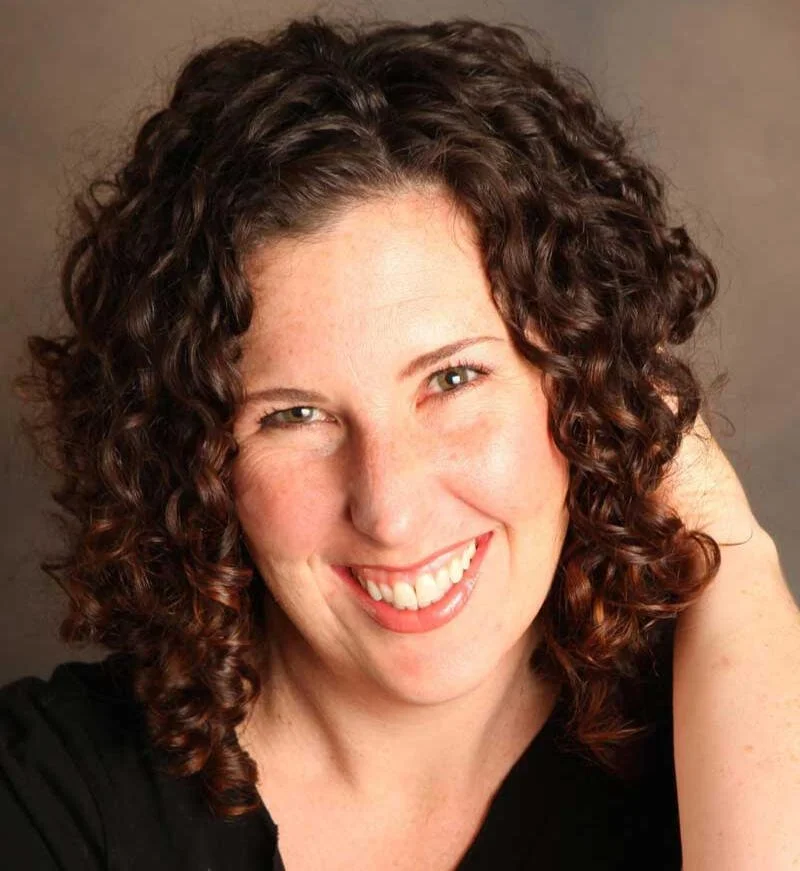
Stephanie Flynn
Stephanie Flynnloves to spread her contagious enthusiasm for fiber with everyone she meets. Her diverse teaching background includes topics in spinning, weaving, knitting, felting, and dyeing. Stephanie’s interest in fiber arts started when she was very young; later, she trained in accessory design at the Fashion Institute of Technology. Online, you can find her weaving class at craftsy.com, and her spinning classes at Schacht’s School of Textile Arts. Stephanie is coauthor (with Jane Patrick) of the book Woven Scarves. Her designs can be found in Spin Off magazine, The Weaver’s Idea Book, and Easy Weaving withLittle Looms. She vows that students are sure to find inspiration in every class she teaches. Meet this instructor and learn more about her in our Five Questions with Stephanie Flynn article.
-
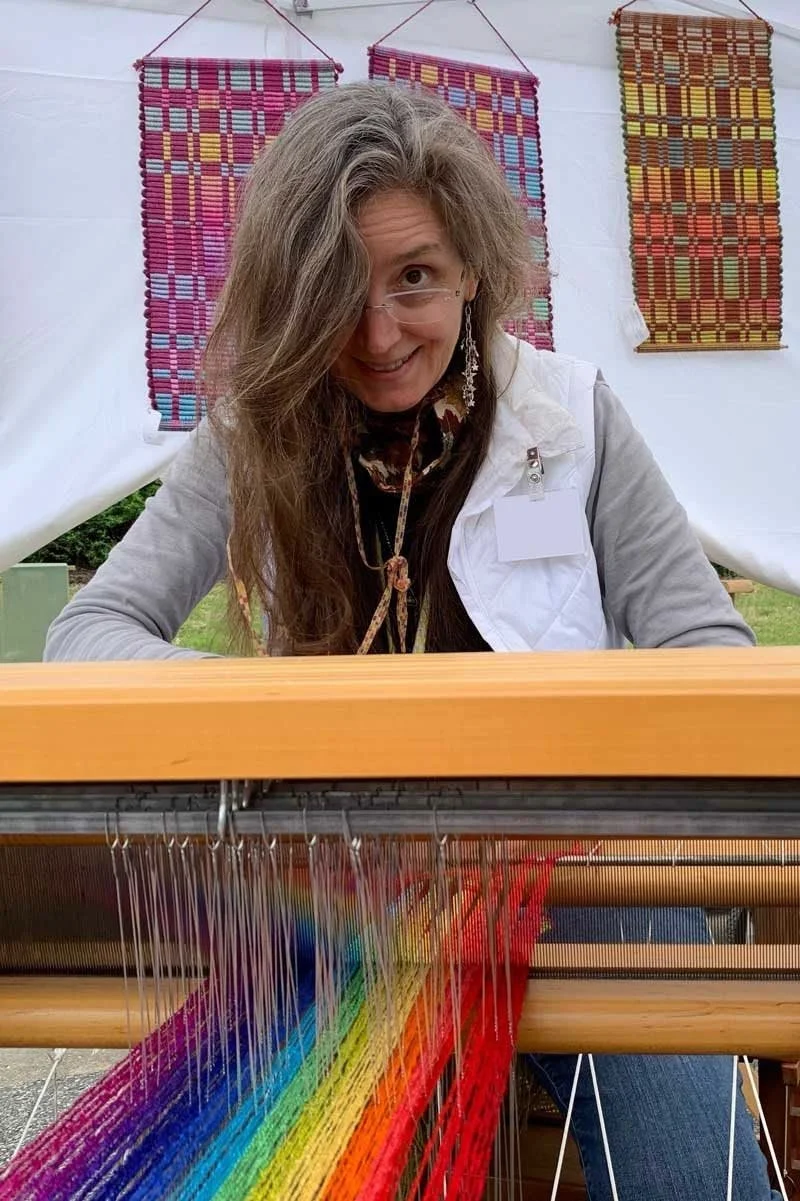
Angela K. Schneider
Angela K. Schneideris a techie and an artist—but above all, she’s a teacher. As Long Thread Media’s project editor, she checks and double-checks project instructions in an impressive range of fiber arts. Her designs regularly appear in Handwoven and Easy Weaving with Little Looms magazines, and she has created everything from delicate jewelry to massive woven installations for public spaces. With a background balancing programming, engineering, and art, plus a Master Spinner Certificate from Olds College, she relishes getting down in the details to understand a textile. One of her greatest joys comes from watching her students’ eyes light up with understanding. In this Five Questions with Angela K. Schneider article, you’ll discover just how much she loves teaching and weaving, as well as her drive to be a lifelong learner.
Itinerary
Classes and activities for multi-shaft AND small-loom weavers alike! More details for the event and class information will be added soon. Schedule is subject to change.
Sunday
Registration begins by 4 pm
Marketplace Opens!
Welcome Dinner & Introductions
Monday
Breakfast
9 am - 12 pm Morning Class Session (3 hours)
Lunch and Marketplace Shopping
1:30 - 4:30 pm Afternoon Class Session (3 hours)
Marketplace Shopping, Dinner, and Evening Activities
Tuesday
Breakfast
9 am - 12 pm Morning Class Session (3 hours)
Lunch and Marketplace Shopping
1:30 - 4:30 pm Afternoon Class Session (3 hours)
Marketplace Shopping, Dinner, and Evening Activities
Wednesday
Breakfast
9 am - 12 pm Morning Class Session (3 hours)
Lunch and Final Marketplace Hours
1:30 - 4:30 pm Afternoon Class Session (3 hours)
Dinner and Evening Activities
Thursday
Breakfast
Checkout & Farewell
Sponsors
-

Yarn Barn of Kansas
The Yarn Barn of Kansas has been supplying Knitters, Weavers, Spinners, and all fiber crafters and artists with yarn, patterns, equipment, and accessories since 1971. Whether you are around the corner from us in downtown Lawrence Kansas, or around the country, the Yarn Barn truly is your "local yarn store" with an experienced staff to answer all your questions. Call us today at 800-468-0035 or visit our website at www.yarnbarn-ks.com to shop, learn, and explore.
-

Long Thread Media
Long Thread Media serves content for the handspinning, handweaving, and traditional needlework communities online, in person, and in print. The company was founded by Linda Ligon, Anne Merrow, and John Bolton to publish Handwoven, Little Looms, PieceWork, Spin Off, and Farm & Fiber Knits, as well as offer information, education, and community to crafters in those fields.
Learn More
Frequently Asked Questions (FAQ)
What classes will be offered?
Classes will cover a variety of looms and topics each day, with many options to choose from as you build your schedule. Whether you are a multi-shaft weaver or love small looms like pin, inkle, tapestry, or rigid-heddle, we’ve got classes with expert instructors that fit your interests.
How long are the classes?
Whether you yearn to learn a new technique or develop your existing weaving skills, we have something for you in this all-inclusive weaving retreat. To build your custom three-day workshop schedule, you’ll choose from a variety of options, including:
- 3-day and 2-day intensives
- 1-day focused courses
- 3-hour seminars and samplers
Class sizes will be small and centered on learning while doing in a stress-free environment.
Can I take just one class?
Because Weave Together is an immersive experience with activities outside class time, classes are available only as part of a 4-day package.
When do I choose classes?
NEW for Weave Together 2026: Participants will be invited to choose classes immediately after purchasing your event ticket. Look for the welcome email and the class survey to arrive shortly after your purchase is complete. To increase your chances of getting your top picks, be sure to complete your class survey and selections as soon as possible.
Is the event handicapped accessible?
The Embassy Suites is ADA-compliant. If you have difficulty with mobility, please let us know so we can provide further details.
Can my spouse/companion attend?
Long Thread Media needs to pre-approve spouses/companions in advance of the event to ensure that we can accommodate them. Due to space limitations, spouses/companions may not attend classes, meals, or activities without pre-approval, and additional charges may apply. Please email our Customer Service team at [email protected] for more information. Attendees who have a guest joining them should choose a private ticket type.
What if I need to change my plans?
You may cancel your registration for any reason up to 90 days before the event for a refund. We charge a 10% processing fee, so you will receive 90% of your payment back.
Can a beginning weaver come to Weave Together?
We’ll have attendees with a range of skill levels and welcome people who are early in their weaving journey. Class descriptions will indicate which sessions are suited to weavers at all levels and what equipment will be needed.
Where will the event be held?
Weave Together 2025 will be held at The Embassy Suites in Loveland, Colorado.
How do I get to The Embassy Suites in Loveland, Colorado?
The Embassy Suites is located at 4705 Clydesdale Pkwy, Loveland, CO, 80538, just off I-25. Click here to get full travel directions from nearby airports. From DIA, you can book a shuttle from Groome Transportation that will take you to the front door of the Embassy Suites. You can book shuttle reservations directly through the Groome website (look for “Loveland – Embassy Suites” for the hotel). We recommend purchasing your plane tickets no earlier than 2-3 months in advance for the lowest prices. The Weave Together itinerary is always subject to change.
